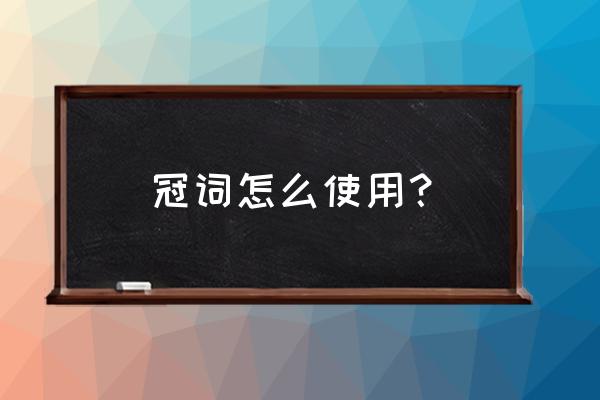冠词的基本用法

用法最法最全总结?
冠词怎么使用?
1、不定冠词的用法不定冠词包括a/an,意思相当于one,在许多情况下,可以翻译成一和每,但不像one同样强调数量,有时不能翻译。
2、法定冠词的使用the后面的名词主要起限定作用,特指是其主要功能。
3.在不使用冠词(零冠词)的情况下,物质名词表示泛指时不使用冠词。抽象名词表示一个概念时不使用冠词。表示国名、地名、人名、城市、街道和首字母Mount在山和大多数湖泊的专有名词之前,不使用冠词。四季、月、节假日、日期、周等名词前不使用冠词。
用法最法最全总结?
冠词是一种虚词。在印欧语系和闪存语系的各种语言中,它位于名词或名词短语的前后。在句子中,它主要是一个限制名词的词。它分为冠词,如the,以及不定冠词,如a和an。
不定冠词a (an)与数词one 同源,是一个的意思。
定冠词的用法
定冠词the与指示代词this,that同源,有那(这)的意思。
1)特指双方都了解的人或物:Take the medicine.把药吃了。
2)上面提到的人或事: He bought a house. I’ve been to the house.
3)指世上独一物二的事物:the sun, the sky, the moon, the earth
4)单数名词用来表示一类事物,例如:the dollar 美元;
the fox 狐狸;或与形容词或分词联合使用,表示一类人:the rich 富人; the living 生者。
5)用于最高级的序数词和形容词,以及形容词only, very, same等前面:
Where do you live? I live on the second floor.你住在哪里?我住在二楼。
6)与复数名词连用,指整个群体:
They are the teachers of this school.指全体教师)
They are teachers of this school.(指部分教师)
7)表示全部,相当于物主代词,用于表示身体部位的名词前:
She caught me by the arm..她抓住了我的胳膊。
8)在一些国家名称、机关团体、阶级等专有名词前使用:
the People‘s Republic of China中华人民共和国
9)用于表示乐器名词之前:She plays the piano.她会弹钢琴。
10) 在姓氏复数名词之前前,表示一个家庭:the Greens格林一家人 (或格林夫妇)
11) 用于惯用语:
in the day, in the morning (afternoon,evening),the day after tomorrow
the day before yesterday, the next morning, in the sky (water,field,country)
in the dark, in the rain, in the distance, in the middle (of),in the end,
on the whole, by the way, go to the theatre
使用零冠词
冠词和形容词 名词结构
1) 两个形容词都有冠词,表示两个不同的东西。
He raises a black and a white cat.他养了一只黑猫和一只白猫。
2) 如果后一个形容词没有冠词,那就指一物。
He raises a black and white cat.他养了一只花猫。
冠词位置
1) 不定冠词位置 不定冠词常用于名词或名词修饰语前。
a. 位于以下形容词之后: such,what,many,half,
such an animal; Many a man
b. 名词前的形容词是副词as, so, too, how, however, enough修饰时,不定冠词应放在形容词后面:It is as pleasant a day as I have ever spent.
c. quite,rather与单数名词连用,冠词放在后面。
但当rather,quite 前面还有形容词,不定冠词前后都可以。quite a lot
d. 在as,though 在引导的让步状语从句中,当标语是形容词修饰的名词时,不定冠词放置形容词后: Brave a man though he is,he trembles at the sight of snakes.
当名词被比较级形容词修饰时,不定冠词通常放置在比较级形容词之后。
2) 定冠词位置 定冠词通常位于名词或名词修饰语之前,但它们被放置在all, both,double,half,twice,three times等词之后,名词之前。
All the students in the class went out.班上所有的学生都出去了。